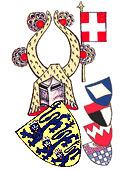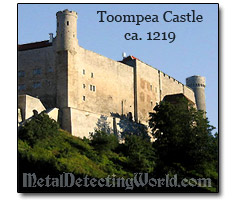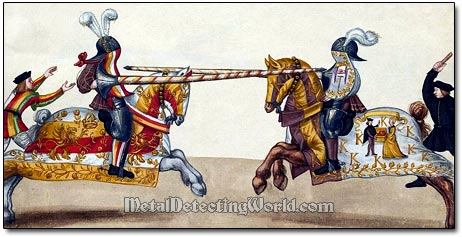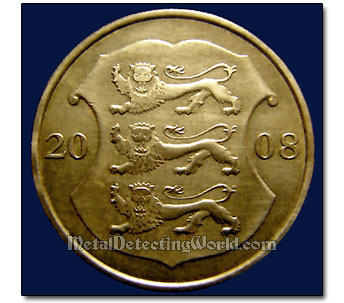Part I - Metal Detecting at the Swedish Tavern Site, page 24
Brief History of Reval's Coat of Arms - Blazon of Estonian Capital Tallinn

The Reval's Coat of Arms - Brief Historical Facts:
The Reval's coat of arms - the three crowned blue lions Passant Guardant (walking leopards, only their heads facing the viewer) on a golden shield, descended from the coat of arms of Danish king Valdemar II (1202-1241). Valdemar II became the first landlord of Reval after his army defeated the Estonians in a battle at Lyndanisse (former name of Reval) in 1219.
According to the legend, during this battle, when the Estonians captured the Danish royal flag, and the Danes were about to give up, a red flag with a white cross on it - the Dannebrog, fell from the sky in the hands of king Valdemar II. This miracle encouraged the Danish troops to fight decisively and win the battle. The date of the battle, June 15, is still celebrated as Valdemarsdag (the national "flag day") in present day Denmark.

After the battle, the Danes built a new fortress - Castrum Danorum ("Castle of the Danes"), at the site of the Lyndanisse fortress on the Toompea ("Cathedral Hill"), which they destroyed during the battle, and gave the city a new name of Reval because the city situated within a district called Rävala or Revalia. The Estonians called the new city Tallinn (in Estonian language "Taani linna" means "the town of the Danes").
Valdemar II presented the new city-fortress of Reval with a coat of arms which was identical to the Danish one - the oldest insignia of knighthood in Europe, thus symbolizing the Danish crown's ownership over the city and the Northern Estonia. The three leopards on a Danish coat of arms symbolized the strength and fortitude - these two qualities more than anything would characterize the new fortress on the Toompea hill, which was repeatedly besieged but never conquered in the following years.
Many structural reinforcements and additions were made to the Toompea stronghold by each of its owners - the Danes (1219-1227, 1237-1346), the Livonian Order (1227-1237, 1346-1561), the Swedes (1561-1710) and the Russians (1710-1918). As a result, the Toompea castle remained one of the strongest citadels in Europe for all 700 years of foreign rule in Reval.
Coats of Arms (or Armorial Achievements, Armorial Bearings) originated in the 10th century when they began intensely appearing at the medieval knights' tournaments, especially at the jousts - combats on horseback between two knights with lances. The Danish coat of arms was established in 1190. In five years, the three leopards also appeared on the armorial of England during the reign of King Richard I the Lion Heart (1157-1199) of the Plantagenet dynasty.
Two Knights Engaged in a Joust (a book illustration fragment, ca. 1550s)

Since the medieval ages, lions most often have been placed on various coats of arms because a lion traditionally would symbolize bravery, valour, strength, and royalty. The exact type of the beast, either a lion or leopard, depicted on the heraldic insignia can be determined by its attitude (position). If the beast is rampant, it is a lion. And it is usually depicted in profile with its tongue sticking out, and the tip of its tail pointing towards its back. If the animal is depicted as walking, with its head shown full face (Passant Guardant), it is a leopard. If the cat is depicted walking and in profile, it is a lion-leopard (lion léopardé - on a French blazon) according to the rules of heraldry.
The golden-yellow shield with three blue leopards was transposed to the coat of arms of the Province of Estonia, which was adopted by Catherine II, Empress of Russia, in October of 1788. The Parliament (Riigikogu) of the Republic of Estonia adopted the Great and Small coats of arms in 1925, on which the leopards did not wear crowns because the crown was a symbol of monarchy, but Estonia became a republic.

After the annexation of Estonia by the Soviet Union in 1940, this coat of arms was banned. The use of the historic coat of arms as the state coat of arms of the Republic of Estonia was re-adopted in August of 1990. The Law on State Coat of Arms was passed in April of 1993.
According to the Law, the coat of arms can be in two shapes, a large coat of arms or a small coat of arms. The large national coat of arms has three blue leopards on a shield with a gold base. The shield is surrounded on three sides by a wreath of golden oak leaves. The smaller coat of arms lacks a wreath.
Upon the passing of the Law, proposals were made in the Estonian Parliament on possible interpretations of the images on the blazon. A consensus was reached on the following suggestions offered by Leopold Raudkepp.
The first leopard symbolizes the courage of the fight for freedom in ancient times. The second leopard stands for the courage in the uprisings in Harjumaa in 1343, when the territories were captured by the Teutonic Order which bought them from Denmark in 1346 and then traded them at a small profit to the Livonian Order. The third leopard represents the courage of the Estonian fight for freedom between 1918 and 1920. Nowadays, the historical coat of arms of Reval can be seen on modern Estonian coins.